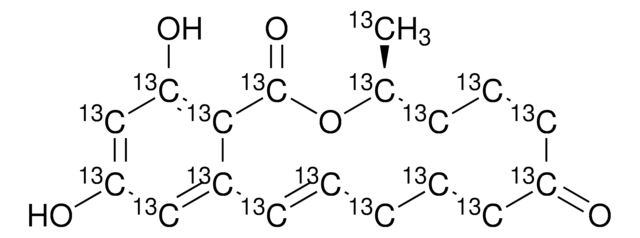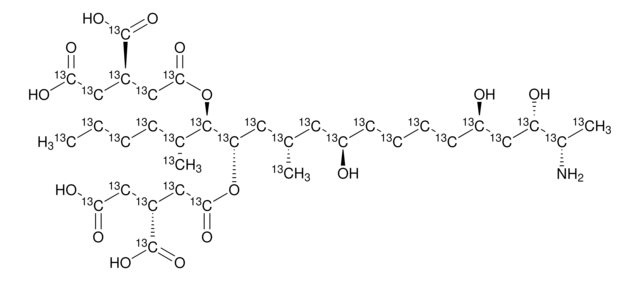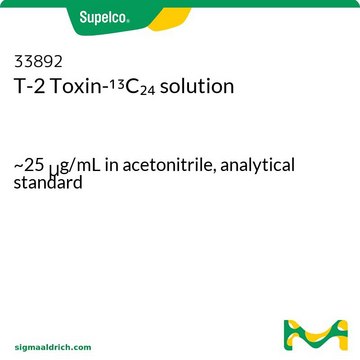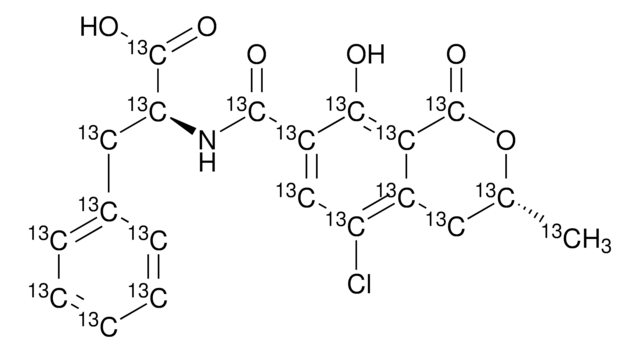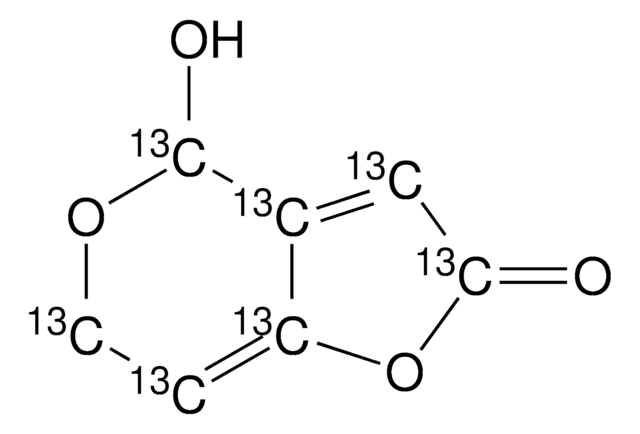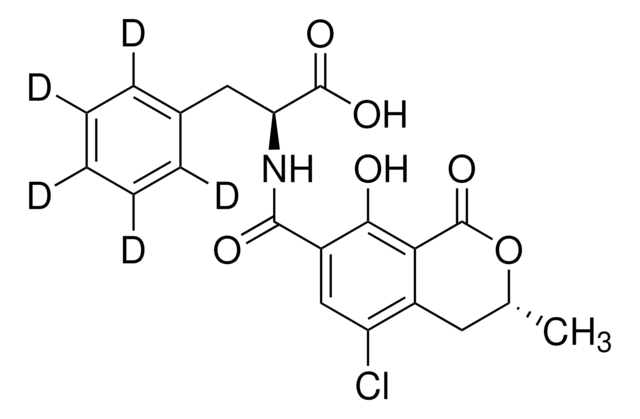Kluczowe dokumenty
34128
Deoxynivalenol-13C15 solution
~25 μg/mL in acetonitrile, analytical standard
Synonim(y):
13C15 DON, Fully 13C-labelled Deoxynivalenol
About This Item
Polecane produkty
klasa czystości
analytical standard
Poziom jakości
okres trwałości
limited shelf life, expiry date on the label
stężenie
~25 μg/mL in acetonitrile
metody
HPLC: suitable
gas chromatography (GC): suitable
Zastosowanie
cleaning products
cosmetics
environmental
food and beverages
personal care
Format
single component solution
przesunięcie masy
M+15
temp. przechowywania
−20°C
ciąg SMILES
[13CH3][13C]1=[13CH][13C@H]2O[13C@@H]3[13C@H](O)[13CH2][13C@@]([13CH3])([13C@]34[13CH2]O4)[13C@@]2([13CH2]O)[13C@H](O)[13C]1=O
InChI
1S/C15H20O6/c1-7-3-9-14(5-16,11(19)10(7)18)13(2)4-8(17)12(21-9)15(13)6-20-15/h3,8-9,11-12,16-17,19H,4-6H2,1-2H3/t8-,9-,11-,12-,13-,14-,15+/m1/s1/i1+1,2+1,3+1,4+1,5+1,6+1,7+1,8+1,9+1,10+1,11+1,12+1,13+1,14+1,15+1
Klucz InChI
LINOMUASTDIRTM-YGEUXOLBSA-N
Opis ogólny
Deoxynivalenol-13C15 (13C15-DON) is the 13C isotope-labelled analog of mycotoxin, Deoxynivalenol. It is a fusarium mycotoxin which belongs to trichothecene class of compounds.
Zastosowanie
- Maize by high performance liquid chromatography (HPLC) electrospray ionization (ESI) mass spectrometry (MS/MS).
- Cereals and cereal-based compound animal feeds by LC-MS/MS operating on selected reaction monitoring (SRM) mode.
- Bioaerosols collected from Serpula lacrymans−damaged homes by HPLC-MS/MS in multiple reaction monitoring (MRM) mode.
- Bread samples by reversed-phase HPLC-ESI with linear trap MS/MS.
It may also be used as an internal standard for the determination of HT-2 toxin, nivalenol and patulin in bioaerosols obtained from dairy cattle shed by HPLC-MS/MS.
Inne uwagi
Hasło ostrzegawcze
Danger
Zwroty wskazujące rodzaj zagrożenia
Zwroty wskazujące środki ostrożności
Klasyfikacja zagrożeń
Acute Tox. 4 Dermal - Acute Tox. 4 Inhalation - Acute Tox. 4 Oral - Eye Irrit. 2 - Flam. Liq. 2
Kod klasy składowania
3 - Flammable liquids
Klasa zagrożenia wodnego (WGK)
WGK 2
Temperatura zapłonu (°F)
35.6 °F
Temperatura zapłonu (°C)
2 °C
Wybierz jedną z najnowszych wersji:
Masz już ten produkt?
Dokumenty związane z niedawno zakupionymi produktami zostały zamieszczone w Bibliotece dokumentów.
Klienci oglądali również te produkty
Nasz zespół naukowców ma doświadczenie we wszystkich obszarach badań, w tym w naukach przyrodniczych, materiałoznawstwie, syntezie chemicznej, chromatografii, analityce i wielu innych dziedzinach.
Skontaktuj się z zespołem ds. pomocy technicznej